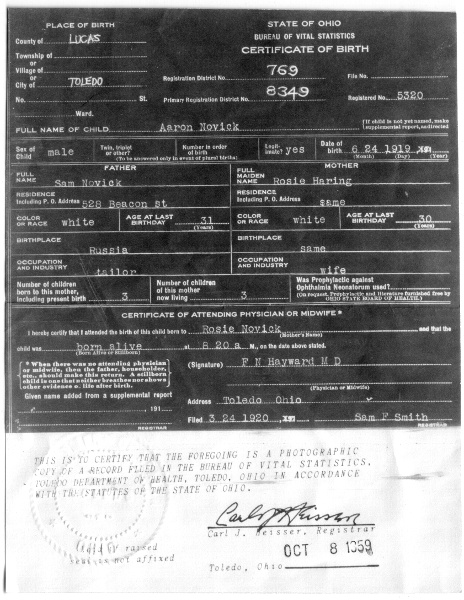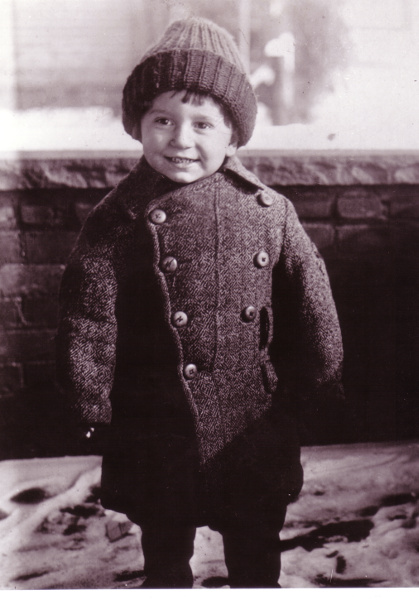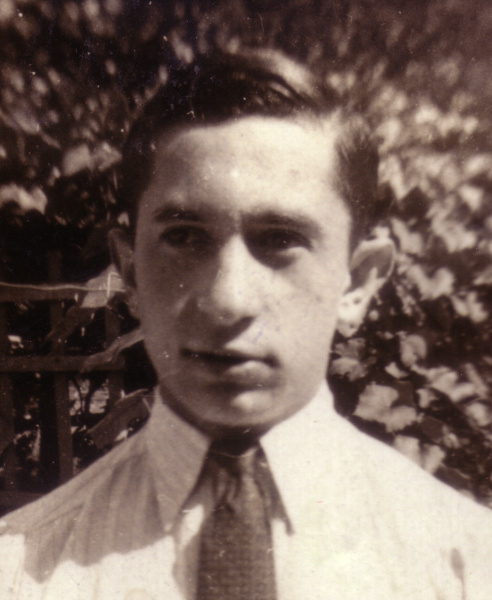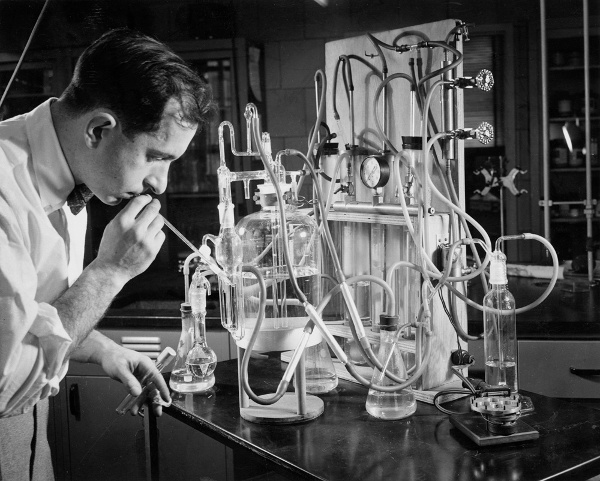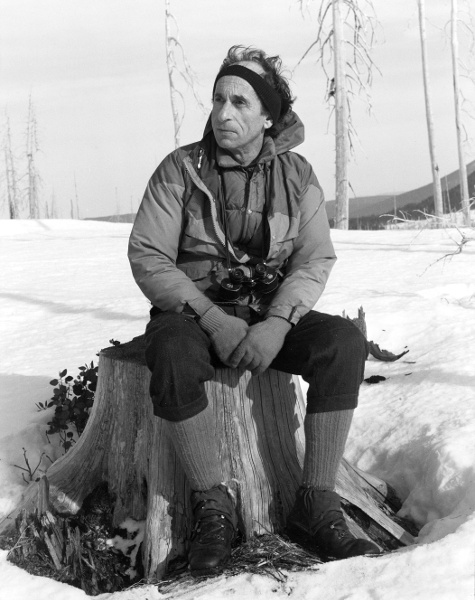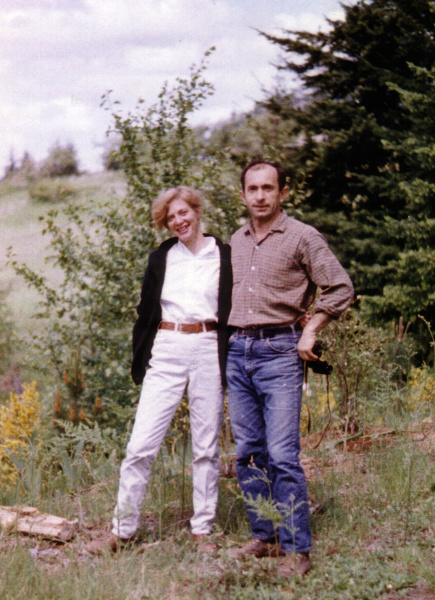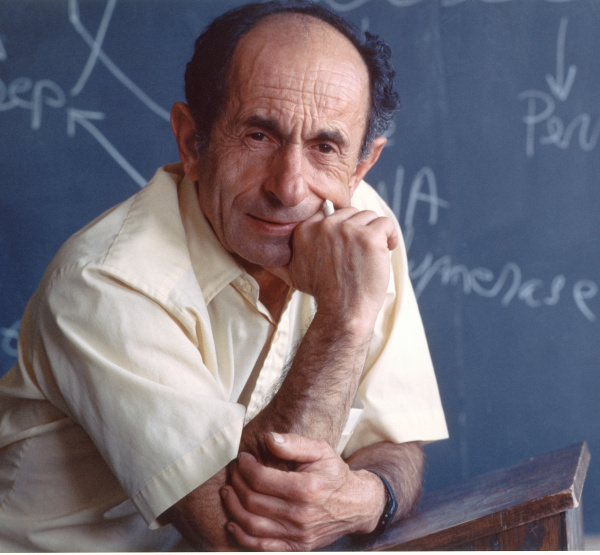Home | About | Faculty | Calendar | Facilities | Graduate program | Contact | Apply
This page is optimized for viewing with javascript.
AARON NOVICK (1919-2000) was a participant in the building of the atomic bomb, a noted student of bacterial gene expression, founding Director of the Institute of Molecular Biology at the University of Oregon, and outspoken advocate of nuclear disarmament.
PARENTS, CHILDHOOD and EDUCATION
Novick and his three siblings (Esther, Meyer and Mary) were born in the United States to Sam Novick, a tailor (born Shimon Novik in 1888 in Lunna, near Grodno, and his wife, Rose Novick nee Haring, born in 1891 in Berestovica, near Bialystok.[a][c] These municipalities were part of Russia at the time, becoming part of Poland in 1919 after a few years of German occupation. Sam and Rose Novick conversed in Yiddish, and Rose never learned to read English.[a]Sam Novick arrived in Philadelphia in 1911 by way of Paris and Liverpool, settling in Manhattan’s Lower East Side, where he continued working as a tailor. He sent for Rose, who joined him there in marriage in January, 1914, under the name Rachael Uren.[z] They arrived in Toledo, Ohio, in August, 1915. Aaron Novick was born there on June 24, 1919, the third of their four children.[a] As a seven-year old schoolboy, Aaron Novick helped his family by selling newspapers.[b] According to a home-town newspaper, “The young Novick knew he wanted to be a scientist and built his first telescope before he turned 12. During the summer of 1936, before his senior year at Woodward High School, Toledo, he and his brother Meyer used a homemade telescope to watch Peltier’s comet, the only Toledoans to do so. Later that year the brothers built a telescope for which they had ground their own lens, a 6.5-inch diameter glass that took more than 15 hours to fashion. Mr. Novick, who also played on Woodward's football team and edited the student newspaper, was elected to the school's hall of fame in 1986.”[b] (Both of Novick’s sons recall that the telescope with the 6.5-inch “glass”, which his family used throughout his life, contained no such large lens because it was a reflecting, not a refracting, one.[q]) Novick earned a bachelor’s degree, class of 1940, at the University of Chicago, supported by a highly selective scholarship.[o] He wrote, “I had come to the University of Chicago with the hope of following a childhood interest in astronomy, but my financial condition dictated something more likely to provide a job.”[p] According to Novick, he supplemented his scholarship by stoking furnaces in the apartment buildings near campus.[q] Novick remained at Chicago for graduate study, receiving a PhD in physical organic chemistry in 1943, with Frank H. Westheimer as supervisor. Upon receiving his degree, Novick was recruited into the Manhattan Project by Leo Szilard and Enrico Fermi.
MANHATTAN PROJECT
Novick wrote: “I first met Leo at the University of Chicago during the Manhattan Project. When I joined the Project in March 1943, I was only 23 with a fresh Ph.D. in chemistry…I was assigned to do experiments on the stability of the graphite for the Hanford reactors…”[e] He was later transferred to Los Alamos, New Mexico, where he witnessed the world’s first atomic detonation at the Trinity Site, related the force of the explosion to the ratio of its isotopic products, and entered the blast site shortly after the detonation to pick up the world’s first materials altered by a nuclear explosion. While at Los Alamos, Novick played football along with mathematician Paul Olum, who re-entered Aaron’s life years later (see POLITICAL ACTIVISM).[i][a][s]Following the test detonation, Novick returned to Chicago, where he purified and measured the half-life of tritium and collaborated with H. L. Anderson to measure the magnetic moment of its nucleus.[dd][ee]
ENTRY INTO BIOLOGY
Novick wrote: “One spring evening in 1947, as we walked through the University of Chicago campus after a meeting of the Atomic Scientists of Chicago, Leo [Szilard] asked me if I would be interested in joining him in ‘an adventure in biology.’ He cautioned me to consider the risks carefully before accepting his offer, but I accepted immediately. It was the chance for an adventure in science I had always dreamed of. To start learning biology, he suggested that we attend the summer course in bacterial viruses organized by Max Delbrück at Cold Spring Harbor, Long Island. This we did. In January, 1948, we started work in our own laboratory at the University of Chicago… Our laboratory was in the basement of the former synagogue of a Jewish orphanage... The ceiling was low, crisscrossed with pipes, and we bought our laboratory furniture from Sears-Roebuck.”[e] In the summer of that year, the two neophyte biologists extended their formal education at Cornelis Van Niel’s summer-long Microbiology course at the Hopkins Marine Station in Pacific Grove, California. Aaron was a full participant, while Szilard audited.[kk]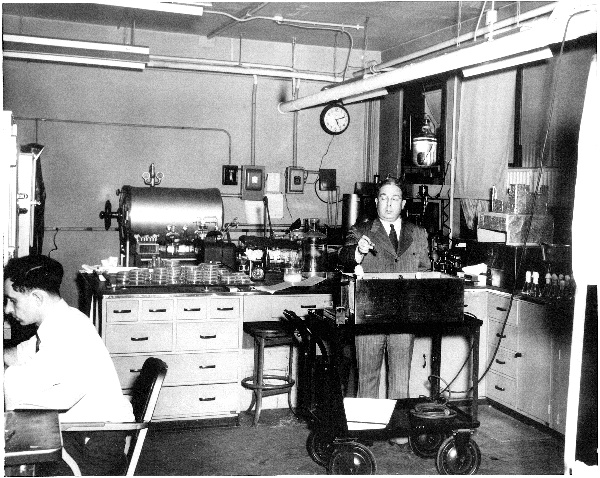
Novick and Szilard, who were early into the field that came to be known as “Molecular Biology”, jointly published half a dozen papers during the period 1949-1954. Their first work involved a demonstration that bacteria killed by ultraviolet light could be revitalized by exposure to short-wavelength visible light (“photoreactivation”). The duo is best known for their invention and application of the Chemostat, a device that permits the long-term maintenance of a bacterial population at a constant population size and rate of growth in a constant volume of liquid. The Chemostat facilitated the investigation of factors that determine growth rate and others that influence mutation rates. It has been widely used in studies of evolution in microbial populations and is a valuable tool in industrial production.[gg][nn]
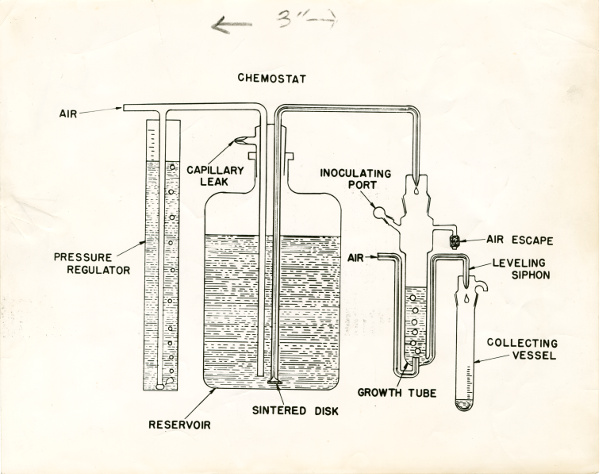
NOVICK IN PARIS
In 1953-54, during his period with Leo Szilard, Aaron studied as a Guggenheim Fellow at the Pasteur Institute in Paris in the company, among others, of François Jacob, Élie Wollman, André Lwoff and Jacques Monod.This visit informed his research in an area that was paramount at the Pasteur Institute at that time -- the mechanism(s) by which bacteria control syntheses of their individual enzymes so that they are produced only when needed. These studies, pursued famously by André Lwoff, Jacques Monod and François Jacob, focused on the enzyme beta-galactosidase, which allows a bacterium to split the disaccharide lactose into two monosachharides, which can then be metabolized to CO2 and H2O, yielding energy for growth. This enzyme is synthesized (“induced”) when lactose, or a lactose analogue, is supplied (in the absence of glucose).
Aaron employed his Chemostat when, with Milton Weiner, he examined the kinetics of induction, under conditions in which individual cells in a partially induced bacterial culture were either making the enzyme at full rate or not making it at all. That is, induction of beta-galactosidase was an all-or-nothing phenomenon. Their work demonstrated that the protein permease, which effected rapid entry of inducer into the cell, was itself induced. Thus, the chance synthesis of a single permease molecule resulted in the rapid, “all-or-nothing” induction of itself and, consequently, of beta-galactosidase. When the inducer concentration was reduced in the chemostat to a “maintenance level”, insufficient for de novo induction, the offspring of the induced cells remained fully induced due to their inherited molecules of permease. This “elegant” analysis is valued as an early, well-studied example of epigenetics in which an acquired characteristic is inherited in the absence of the condition that promoted the acquisition.[ff]
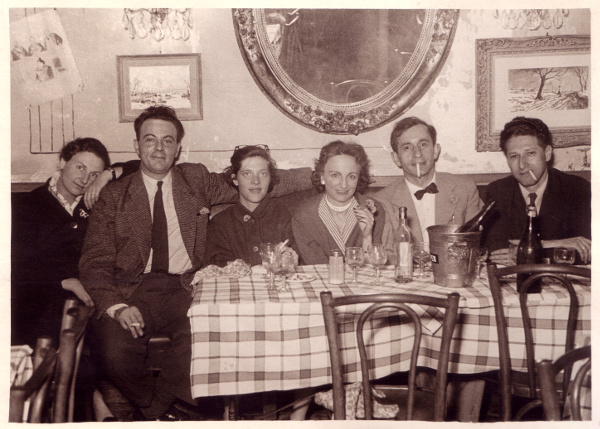
AARON’S INSTITUTE
In the late 1950s, Aaron elected to do science on his own. After a brief period that involved (1) declining an offer to head a proposed Institute of Molecular Biology conceived by Terrell Hill (1917 - 2014) at the University of Oregon, (2) accepting an offer from the University of California in San Diego, (3) and, after a closer look, deciding that the San Diego County political ambience was not for him, Aaron asked Oregon if the job was still open and, when informed it was, negotiated terms and signed up.[k]Aaron’s skill as Director, combined with the geographic and climatic attractions of Oregon’s Willamette Valley, the vaunted livability of Eugene and the soundness of Terrell Hill’s concept, secured the success of the Institute at a time when federal funding in response to Sputnik and the lumber boom in Oregon provided strong support.
Despite his evident fondness for football, Novick was, apparently, somewhat self-conscious about affiliating with a University that had a NCAA Division I football program. When he showed Frank Stahl, the first recruited member of his Institute, the diminutive wooden stands of Hayward Field (which was used in 1960 for football as well as for the University’s more illustrious track and field program), he explained that football was not taken too seriously at Oregon.[q]
The history of the Institute’s first 50 years has been reviewed [m][u], and a more personal history [t] has been written by Lotte Streisinger, wife of George Streisinger (1927-1984), Aaron’s second recruit to the Institute.
Of the many contributions to molecular biology made by the Institute, several illustrate the value of the founding principle of bringing together scientists with common interests but different formal backgrounds. Notable among these is the interaction of Streisinger’s studies of bacteriophage mutants that had reduced stability of endolysin protein with studies on protein structure and assembly by Brian Mathews, John Schellman and Rick Dahlquist.[hh] A different, but equally important kind of collaboration effected by Terrell Hill’s vision and Novick’s direction, was the eagerness of Streisinger’s colleagues to support his ambitious aim of establishing zebrafish as a model organism for studies on genetics, development, and physiology of vertebrates.[q]
In 1994, Novick wrote, “I have been very happy in Eugene, where I started an Institute of Molecular Biology in 1959. It has been very successful, which led to its becoming a large thing. I miss the fun when we were smaller.”[v]
IN OREGON
Novick’s rate of adaptation to Oregon, Eugene, and the University was notable.[q] When Stahl made his “job-visit” to Eugene, a few months after Novick arrived there, he was impressed with how many people Novick knew and how familiar he was with points of interest in the city and surrounding countryside. Novick’s ability to introduce recruits to the interesting people and the glorious scenery of Oregon served him well in building his Institute. His colleagues and students treasure memories of the cross-country ski adventures that he led in Oregon’s Cascade Mountains.[m][q] Within a year after his arrival, Aaron and Jane had purchased a house on two acres on the edge of town. The rural setting and dry Oregon summers were good for stargazing. To clear and maintain the grounds they borrowed a flock of pregnant ewes and bought a donkey.
POLITICAL ACTIVISM
Like that of other participants in the Manhattan Project, the sense of guilt over the mass incineration of the civilians of Hiroshima and Nagasaki not only drove Novick out of physics into biology, but also into a lifetime of anti-war activities.[o] He involved himself in advocacy for the civilian control of nuclear activities as early as 1946, when he served as Vice Chairman of the Atomic Scientists of Chicago.[oo] He demonstrated at that time his willingness to speak truth to power when he publicly and forcefully contradicted politicians who distrusted the motives of scientists who advocated for civilian control.[pp]Such activities are remembered in Paris as “A partir de 1945, devient un militant pacifiste, opposé à la prolifération des armes nucléaires.”[w]
Novick’s activism extended from meetings with local school children to service on committees and publications of local, state, and national significance dealing with issues of civilian control of nuclear power and weapons, nuclear disarmament, anti-ballistic missile treaties, requirement for peace in the nuclear age, disposal of America’s chemical munitions, space travel, and biology education, among others.[x] The arrival in Eugene in 1976 of Los Alamos teammate Paul Olum as University Provost and, later, President provided Novick an energetic collaborator in these activities.[cc]
Novick helped a local group (of which Jane Novick was a key member) stop the Eugene Water and Electric Board from building a nuclear power plant. His estimate of Eugene’s future power needs was well below that of EWEB. Possibly influenced by such uncertainty, Eugene citizens voted to delay a decision on the power plant. During that delay, data on actual power use demonstrated that Novick’s estimate was spot on, and the nuclear project was abandoned.[h]
Novick’s activism opened the door for the members of his Institute to participate in Eugene’s vocal, and sometimes turbulent, anti-war activities, leading University of California molecular biologist Gunther Stent to refer to Eugene as “Berkeley North.”[y][q]
AS ACADEMICIAN
Novick maintained an active laboratory in the Institute of Molecular Biology from his arrival in Eugene in 1959 until 1971. His research accomplishments are summarized by his list of scientific publications, most of which expand on the studies arising from his interactions with Jacob and Monod. Novick enjoyed teaching, firm in his belief that teaching and research are synergistic.[q] From 1971 onward, Novick served the University variously as Graduate Dean, Chairman of Biology, and Director of the Institute of Molecular Biology, while continuing to teach and maintain an involvement in peace-oriented activities, both locally and worldwide. After 1984, he contributed as Institute Director on a one-third appointment until he became Emeritus in 1990. In retirement, he suffered from Parkinson’s disease and died of pneumonia on December 21, 2000.Aaron Novick was notable as a pioneering scientist, a developer of the atomic bomb, inventor, educator, administrator, advocate of arms control, avid cross-country skier, hiker, editor (Bulletin of the Atomic Scientists, Bacteriological Reviews), amateur astronomer[d], football player, pickle maker[aa], and accomplished preparer of Chinese food.[o] He asked to be remembered as “honest and a Democrat”.[jj]
SCIENTIFIC PUBLICATIONS
(possibly incomplete listing)- With F. H. Westheimer, 1943 The kinetics of the oxidation of isopropyl alcohol by chromic acid, The Journal of Chemical Physics 11: 506-512.
- With nine others, Neutron-induced decomposition of graphite. Argonne National Laboratory, Chemistry Division, ANL-5472. Retrieved 5-8-2015. The individual parts of this study involving Novick were published in 1956 in the Journal of Applied Physics:
- 3e. Neutron-Induced Discomposition in Graphite. V. Thermal Conductivity Measurements, with A. R. Van Dyken, M. G. Bowman and A. Novick, J. Appl. Phys. 22: 570 (1956).
- Neutron-Induced Discomposition in Graphite. VI. Rate of Healing Experiments, with A. Novick, J. Appl. Phys. 27: 570 (1956).
- Neutron-Induced Discomposition in Graphite. VII. Assymptotic Annealing Experiments, with A. Novick and A. R. Van Dyken, J. Appl. Phys. 27: 571 (1956).
- Neutron-Induced Discomposition of Graphite. X. Rate of Bromine Absorption, with A. Novick, J. Appl. Phys. 27: 572 (1956).
- A. Novick, 1947 Half-life of tritium. Phys. Rev. 72: 972.
- With H. L. Anderson, 1947 The magnetic moment of the triton. Phys. Rev. 71: 372.
- With L. Szilard, 1949 Experiments on light-reactivation of ultra-violet inactivated bacteria. Proc. Natl. Acad. Sci. 35: 591-600.
- With L. Szilard, 1950 Description of the chemostat. Science 112:715-716.
- With L. Szilard, 1950 Experiments with the chemostat on spontaneous mutations of bacteria. Proc. Natl. Acad. Sci. 36: 708-719.
- With L. Szilard, 1951 Experiments on spontaneous and chemically induced mutations of bacteria growing in the chemostat. Cold Spring Harbor Symp. Quant. Biol. 16: 337-43.
- With L. Szilard, 1954 Anti-mutagens. Nature 170: 926-27.
- With L. Szilard, 1954 Experiments with the chemostat on the rates of amino acid synthesis in bacteria. In Dynamics of Growth Processes, Growth Symposium No. 11 (E. J. Boell, ed.), Princeton Univ. Press, Princeton, NJ, pp 21-32.
- A. Novick, 1955 Growth of bacteria. Annual Review of Microbiology 9: 97-110.
- A. Novick, 1956 Mutation: Brookhaven Symposia in Biology 8: 201
- With M. Weiner, 1957 Enzyme induction as an all-or-none phenomenon. Proc Natl Acad Sci USA. 43: 553–566.
- A. Novick, 1958 Genetic and physiological studies with the chemostat, in Continuous Cultivation of Microorganisms, a Symposium, Prague. Publ. House Czechoslov. Acad. Sci, 45.
- A. Novick, 1958 Experimentation with the chemostat. Recent Progress in Microbiology, Symposia at VII International Congress of Microbiology 1958.
- With M. Weiner. 1959 The kinetics of beta-galactosidase induction. A Symposium on Molecular Biology. R.E. Zirkle, editor. University of Chicago Press, Chicago. pp 78–90.
- With E. A. Glass, 1959 Induction of mutation in chloramphenicol-inhibited bacteria, J Bacteriol. 77: 10–16.
- A. Novick, 1960 Some chemical bases for evolution of microorganisms, p 533-546 In A. A. Buzzati-Traverso (ed.) Perspectives in Marine Biology, Scripps Institute of Oceanography.
- With T Horiuchi and S Horiuchi, 1961 A temperature-sensitive regulatory system, J. Mol. Biol. 3: 703-704.
- With T. Horiuchi, 1961 Hyper-production of beta-galactosidase by Escherichia coli bacteria, Cold Spring Harb. Symp. Quant. Biol. 26: 239-245.
- With T. Horiuchi, 1961 A thermolabile repression system, Cold Spring Harb. Symp. Quant. Biol. 26: 247-248.
- A. Novick, 1961 Bacteria with high levels of specific enzymes. In M. X. Zarrow (ed), Growth in living systems, Purdue Growth Symposium, pp 93-106.
- With T Horiuchi and J-I Tomizawa, 1962 Isolation and properties of bacteria capable of high rates of beta-galactosidase synthesis. Biochimica et biophysica acta 55: 152-63.
- With E. B. Horowitz, 1962 The autonomy of the galactokinase-forming gene.Biochimica et Biophysica Acta 58: 590–592.
- With T. Horiuchi and S. Horiuchi, 1963 The genetic basis of hyper-synthesis of beta-galactosidase, Genetics 48: 157–169.
- With B. S. Guttman, 1963 A messenger RNA for alpha-galactosidase (sic) in Escherichia coli, Cold Spring Harb. Symp. Quant. Biol. 28: 373-374.
- With T. Horiuchi,1965 Studies of a thermolabile repressor, Biochimica et Biophysica Acta - Nucleic Acids and Protein Synthesis 108: 687–696.
- With J. M. McCoy and J. R. Sadler, 1965 The non-inducibility of repressor formation. J. Mol. Biol. 12: 328–330.
- With W. L. Fangman, 1968 Characterization of two bacterial mutants with temperature-rensitive synthesis of DNA, Genetics 60: 1–17.
- With S. D. Barbour and C. Gross, 1968 Growth-instability of repressor. J. Mol. Biol. 33: 967–969.
- With V. A. Fried, 1973 Organic solvents as probes for the structure and function of the bacterial membrane: effects of ethanol on the wild type and an ethanol-resistant mutant of Escherichia coli K-12. J. Bacteriol. 114: 239-248.
- With G. Cowley, 1986 Review of Mind from Matter? An essay on Evolutionary Epistemology by Max Delbrück). The Sciences 86: 54-60.
NOTES
[a] Adam Novick, Interview.[b] “Toledoan a nuclear, biological pioneer”, The Blade 12/24/2000. Retrieved 4-26-2015.
[c] Eileen Soffer (AN’s niece by marriage) email to Adam Novick.
[d] “Oregon science pioneer Aaron Novick dies at 81”. R. L. Hill, The Oregonian, Portland OR, 12/23/2000 (University of Oregon Archives, Aaron Novick Collection).
[e] Aaron Novick, with Gene Dannen, (1998) in Adventure in Biology and Ideas, George Marx (editor), Leo Szilárd Centenary Volume (Budapest: Eötvös Physical 4-26Society).
[f] Wigner, Eugene P. (1969) “Leo Szilard 1898—1964, A Biographical Memoir”, National Academy of Sciences, Washington D.C.
[g] Gibbons, Glen (November 19, 1981) “Aaron Novick: Memories of Manhattan”. Willamette Valley Observer.
[h] Pope, Daniel (1990) We Can Wait. We Should Wait. Eugene's Nuclear Power Controversy, 1968-1970. Pacific Historical Review.
[j] Letter from Hope Pressman to UO President, Paul Olum. University of Oregon Archives, Aaron Novick collection.
[k] Hager, Tom, 1984 The Making of an Institute. Old Oregon, 64: 22-27.
[l] Comments in Memory of Aaron Novick, Peter von Hippel, 01/21/2001.
[m] University of Oregon’s Institute of Molecular Biology Celebrates 50 Years, Tachibana, Chris, ASBMToday January, 2010. Retrieved 4/23/2015.
[o] The atom - man’s great questions. Richard Read, The Oregonian (Portland), 10/04/84.
[p] Letter from AN to F. H. Westheimer (3-5-92), University of Oregon, Aaron Novick Collection.
[q] Original Citation.
[r] Manhattan Project Heritage Preservation Association, Inc.
[s] ; Letter from AN to RG Editor Don Robinson, July 20, 1995, University of Oregon Archives, Aaron Novick Collection).
[t] “From the Sidelines”, Streisinger, Lotte. University of Oregon Press (2004).
[u] “Aaron’s Acorn”, Oregon Quarterly Winter 2009. Retrieved 4-23-2015.
[v] Letter AN to Edward Teller, 5-13-1994; University of Oregon Archives, Aaron Novick Collection.
[w] Institute Pasteur Archives.
[x] University of Oregon Archives, Aaron Novick Collection.
[y] How Activism during the Vietnam Era Influenced Change in the Student Role on Campus, ChapmanGraves, Camas, 2005. Scholars’ Bank, University of Oregon. Retrieved 4-24-2015.
[z] State of New York, Certificate and Record of Marriage.
[aa] Bambu Batu, Sour puss: Summer pickle recipe. Retrieved 4-26-2015.
[cc] Beres, George, 2001 Warriors for Peace. The work of Aaron Novick and Paul Olum must continue. Eugene Weekly. Retrieved 4-27-2015.
[dd] Text, Half-life of Tritium. Retrieved 5-7-2015.
[ee] Text, Magnetic Moment of the Triton. Retrieved 5-7-2015.
[ff] José M. G., Vilar, J., Lin, C., Guet, C., and Leibler, S, 2003 Modeling network dynamics: the lac operon, a case study. The Journal of Cell Biology 161: 471-476. Retrieved 5-7-2015.
[gg] Miller, A. W., Befort, C., Kerr, E. O. and Dunham, M. J., 2013 Design and Use of Multiplexed Chemostat Arrays. J Vis Exp. 72: 50262. Published online 2013 Feb 23. doi: 10.3791/50262.
[hh] Baase, W., Liu, L., Tronrud, D. E., and Matthews, B. W., 2010 Lessons from the lysozyme of phage T4. Protein Sci. 19: 631–641.
[jj] Minutes of the University Assembly Meeting, Wednesday May 30, 2001. Retrieved 5-6-2015.
[kk]Spath, S. B., 1999 C.B. van Niel and the Culture of Microbiology, 1920-1965. A dissertation submitted in partial satisfaction of the requirements for the degree of Doctor of Philosophy, University of California, Berkeley. http://notecat.net/cyan/diss/ch4.htm. Retrieved on July 8. 2015.
[nn] The Michigan Chemical Process Dynamics and Controls Open Text Book. Bacterial Chemostat Model. Retrieved 5-22-15.
[oo] University of Chicago Library, Guide to the Atomic Scientists of Chicago Records 1943-1955 Retrieved 5-30-15
[pp] Chicago Tribune, 7-12-46. Retrieved 5-30-15.
